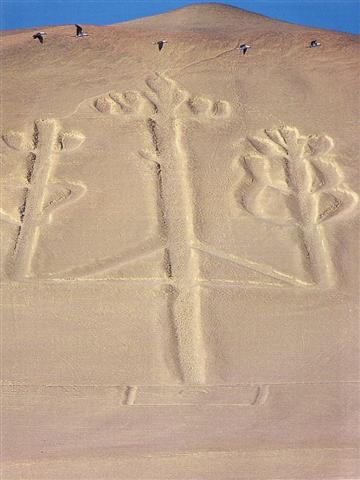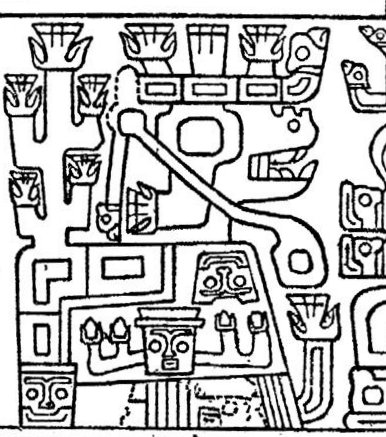3. Then there is the pictorial arguments of the 'Candelabra of the Andes'
Below the 5 birds which (appropriately) happen to fly by there is the figure of a great 'candelabra' with 3 arms 'engraved' on the mountain slope, and on the arm at right there appears to be a squirrel-like creature climbing up the 'stairs' (which do not appear on the left arm). Maybe there is a similar little beast, without head, on the other side of the right arm. 'Two thousand miles of empty ocean and the deeps of the Chile Basin separate Easter Island from the west coast of South America. A due-east course would lead voyagers from the island to make landfall in Chile. But a course somewhat to the north of east might bring a ship eventually to the safe haven of the bay of Paracas in Peru, which lies on a meridian exactly 180 degrees of longitude east - and west - of the temples of Angkor in Cambodia. We came across the water from the north in a small open boat, skirting the arid Balestas islands, now a marine sanctuary, and heading for the Paracas peninsula, where rolling sandstone hills and escarpments drop steeply into the sea. From more than 15 kilometers off-shore we had been able to make out the so-called 'Candelabra of the Andes', first through binoculars and then in direct sight. It lay due south of us, carved into a sloping cliff, looming ever larger in our field of view as we approached. The scholarly consesus is that this huge earth-diagram could easily be 2000 years old and is most likely to have been the work of the same people who created the better-known Nazca lines which are found inland, some 300 kilometers to the south. This 'Nazca culture', about which very little is known, is thought to have flourished from the second century BC until about 600 AD. The 'Candelabra' has a rectangular, box-like base, enclosing a circle, out of which rises the representation of a wide central vertical bar, more than 240 meters in length, running north to south. This is crossed, about one-third of the way up, by a triangular contraption running east to west for some 120 meters, supporting two shorter vertical bars. All three bars are surmounted by curious patterns generally interpreted as flames or rays of light. Because of its auspicious geodetic location half-way round the world from Angkor and 108 degrees west of Giza - sites that both 'resemble the sky' by modelling specific constellations on the ground - we have naturally considered the possibility that the Candelabra could be a work of celestial imitation. What particularly invites this enquiry is the orientation of the diagram. It is set very closely to true north-south, the meridian of the sky, the great dividing-line across which astronomers in all cultures have traditionally observed the 'transits' of stars. The Candelabra was intended by its designers to be seen from the north. Indeed, there is no other perspective from which it may be satisfactorily viewed: the observer must face south towards the sloping escarpment on which it is carved. Examining the diagram from the base up naturally draws the eyes towards the southern sky above the escarpment, and specifically towards the south meridian. Although it may be entirely coincidental, computer simulations tell us that at around the hour of midnight on the March equinox 2000 years ago - the epoch in which the Candelabra was probably made - the constellation known as Crux (the Southern Cross) would have been seen lying on the south meridian at an altitude of 52 degrees. At that moment an observer positioned on a boat as we now were, about a kilometre north of the Candelabra, would have seen the Southern Cross suspended in the sky directly above the great cliff diagram.' (Graham Hancock, Heaven's Mirror. Quest for the Lost Civilization.) 52° above the horizon could be a coincidence, but probably it would have been associated with 364 / 7 = 52, I think, the number of weeks in a year. Numbers were important in those days because they were indisputable and signs of the order created by light (life):
The rightmost column shows the interior angles of each of the regular polygons. Thinking man all over the ancient world must have been well aware of such facts. The location 108° west of Giza for the Candelabra of the Andes is a natural choice. The basic number of the pentagon is 5 (rima), which corresponds to the number of fingers on a hand. But rima is evidently also equal to 'arms' in general - which the myth about Mahuika tells us. The tips of her 'fingers' (i.e. the nails of her hands and feet) delivered fire, and the 'cactus tree' on the backside of the 'hippopotamus' (the 'river horse') also delivers fire from the tips of its 5 limbs:
|

